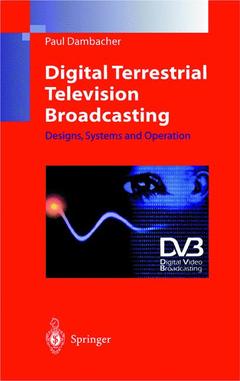Description
Digital Terrestrial Television Broadcasting, Softcover reprint of the original 1st ed. 1998
Designs, Systems and Operation
Author: Dambacher Paul
Language: French
Subjects for Digital Terrestrial Television Broadcasting:
Approximative price 52.74 €
In Print (Delivery period: 15 days).
Add to cart
Publication date: 10-2012
243 p. · 15.5x23.5 cm · Paperback
243 p. · 15.5x23.5 cm · Paperback
Description
/li>Contents
/li>Comment
/li>
In the past decades, traditional television broadcasting has been an autonomous field which was largely independent of the world of telecommunications and computers. The analog television standards PAL, SECAM and NTSC have remained almost untouched with regard to their picture information. Whatever development took place was essentially in support of programming and was based on the existence of a certain redundancy in the representation of the signal in the time and fre quency domain. In the 70S, for example, the teletext system was introduced throughout Europe. A further supplementary digital service in television, intro duced in the early 80S, was the Video Programme System (VPS) which utilizes part of the TV data line and ensures that programmes can be recorded with the correct timing on video recorders even when the programmes are delayed. There is no doubt that as far as the transmission from the studio to the view er is concerned, the future belongs to digital video broadcasting (DVB) which is about to be implemented in the satellite, cable and terrestrial radio transmission media. The European DVB Project finalized its specification for channel coding and modulation for the digital broadband transmission channels at the begin ning of 1996.
1 History of the Development of Digital Transmission Techniques in TV Broadcasting.- 1.1 Growth in the Proportion of Digital Signal Transmission in Television Engineering.- 1.2 Beginnings of Digital HDTV in the United States.- 1.3 Research Projects and Pilot Developments in Europe.- 1.4 Specification by the European DVB Project.- 2 Present State of the Terrestrial Television Broadcasting Service.- 2.1 Programme Feeds to the Transmitting Stations.- a) Microwave and Cable.- b) Broadcast Satellites.- 2.2 Signal Transmission Technology.- a) Overview.- b) Dual-Sound Carrier Method.- c) NICAM Method.- d) The Data Line Technology.- 2.3 Television Transmitter Engineering.- a) Overview.- b) 20-kW UHF TV Transmitter with Tetrode.- c) 10-kW Solid-State UHF Transmitter.- d) Further Development in TV Amplifier Technology.- 2.4 Basic Measuring and Monitoring Methods.- a) Automatic Frame Measuring Technique.- b) Test Line Monitoring Technique.- c) Measurement Parameters in the Dual-Sound Carrier Method.- d) NICAM Measuring Method.- 2.5 Planning of Coverage.- a) Antenna Technology.- b) Planning Guidelines.- 3 Basic Principles of Digital Television Transmission.- 3.1 Video Coding.- 3.2 Audio Coding.- 3.3 MPEG-2 Transport Stream.- 3.4 Channel Coding and OFDM Methods.- 3.5 Single-Frequency Network.- 4 Basic Parameters of the Specification for the Digital Terrestrial TV transmission.- 4.1 Channel Coding.- 4.2 Quadrature Amplitude Modulation.- 4.3 Basic Changes Compared with the Present Broadcasting Service.- a) Principle of the DVB Transmitter and Receiver.- b) Differences in the Digital Terrestrial Broadcasting Service.- 5 Programme Feeds to the Digital Terrestrial Transmitting Stations.- 5.1 MPEG-2 Signal Feed.- a) Satellite Uplink.- b) Satellite Downlink Reception at the Terrestrial Transmitting Station.- c) Programme Transfer with the Baseband Coding.- 5.2 Programme Feed Alternatives.- 5.3 Pragmatic Approaches to an Implementation.- a) Basic System of the Established DSR Method.- b) Increased Data Capacity via Types of Modulation with 4 Bits per Symbol.- 6 Technology of Terrestrial DVB Transmitters.- 6.1 Design for the Development of the OFDM Modulator.- a) 8K/2K IFFT and Digital I/Q Modulation.- b) Modulator for Optimized Patterns.- 6.2 Dimensioning Parameters for the Hierarchical Transmission.- a) Simulation Programme.- b) Analysis of the Measurement Results.- 6.3 Correction of Tube and Transistor Power Amplifiers for OFDM Signals.- a) Effects of Non-Linear Amplifier Characteristics.- b) Measurement Results from Adapted Multi-Carrier Power Amplifiers.- c) Further Developments in Optimizing Equalization and Efficiency.- 6.4 Combined TV Transmitters for DVB and PAL Signals.- 7 Test Methods for the Digital Terrestrial Television Transmitter.- 7.1 Generating OFDM Signals.- a) Data Source and I/Q Modulator.- b) The Personal Computer as a Tool.- 7.2 Measurement Parameters for the Optimization and Acceptance of DVB Transmitters.- a) Bit Error Rate.- b) Vector Signal Diagram.- c) OFDM Transmitter Power.- d) Real-Time Measurement of the Amplifier Operating Characteristic.- e) Measurement and Operating Parameters for the Acceptance of a DVB Transmitter.- 8 Synchronization of the DVB Transmitters in a Single-Frequency Network.- 8.1 Global Positioning System GPS.- 8.2 Frequency Synchronization of the Carrier.- 8.3 Time Synchronization for Bit-Synchronous Transmission.- 9 Techniques of Measuring the Coverage of Digital Terrestrial Television Networks.- 9.1 Detection and Analysis of the Field Strength.- a) Channel Model.- b) Field Strength Measurement.- c) I/Q Demodulator.- 9.2 Measuring the Channel Impulse Response and the Raw Bit Error Rate.- a) Methods for Calculating the Channel Impulse Response.- b) Channel Impulse Response Measurement in the DVB Network.- c) Approach to Determining the Selective C/I Value and the Raw Bit Error Rate.- d) Configuration and Measuring and Monitoring Characteristics of the Impulse Response Analyzer.- e) Mobile DVB Test Receiver.- 10 Outlook.- 10.1 Development of the of Satellite and Cable Media.- 10.2 Realization of the Potentials of Digital Television Broadcasting.- 10.3 Change in the Channel Frequency Structure.- 10.4 In-Service Monitoring of Transmitter Networks.- 10.5 A Long-Term Scenario for Digital Terrestrial Television.- 11 Summary.- 12 List of References and Sources.- 13 List of Abbreviations and Formula Symbols.- 14 Index.
Book gives an application-oriented overview of the technolo- gy of DVB-T, which is a hot topic at present.
The author is an experienced industrial expert.
Target groups are engineers in modern information and communication technology.
© 2024 LAVOISIER S.A.S.




